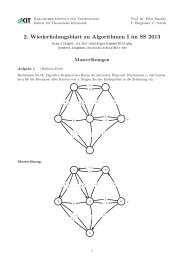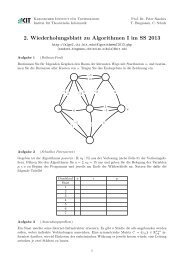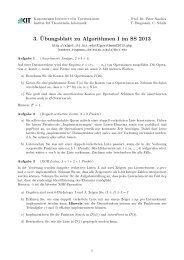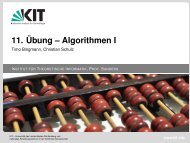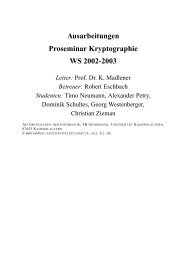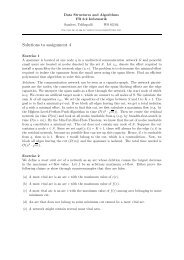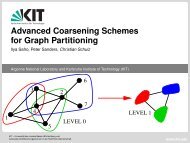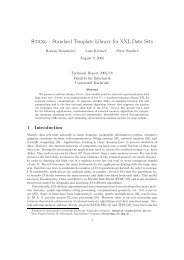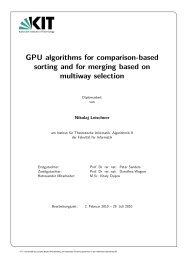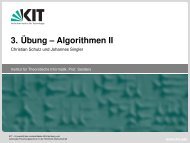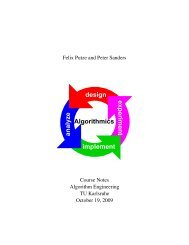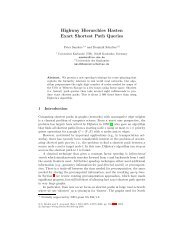LNCS 3142 - The Power of Verification for One-Parameter Agents
LNCS 3142 - The Power of Verification for One-Parameter Agents
LNCS 3142 - The Power of Verification for One-Parameter Agents
Create successful ePaper yourself
Turn your PDF publications into a flip-book with our unique Google optimized e-Paper software.
172 V. Auletta et al.<br />
that the optimization problem can be solved on the real input. We consider the<br />
following conceptual scenario with m agents identified by the integers 1, ···,m.<br />
Each agent i has a private type ti and a public valuation function vi such that<br />
vi(X, ti,σ) measures how much agent i likes solution X <strong>for</strong> instance σ. Amechanism<br />
is a pair M =(A, PA). A is an algorithm that, on input an instance<br />
σ and the reported types b =(b1,b2,...,bn) (bi is the type reported by agent<br />
i), computes a solution X = A(b, σ). Moreover, the mechanism awards to each<br />
agent i a payment P i A (b, σ), where PA =(P 1 A , ···,Pm A<br />
). We define the utility (or<br />
pr<strong>of</strong>it) u i M (b, σ|ti) <strong>of</strong> agent i on instance σ, when the type <strong>of</strong> agent i is ti and<br />
b =(b1, ···,bm) are the declared values <strong>of</strong> the m agents in the following way<br />
u i M (b, σ|ti): = P i A(b, σ)+v i (X, ti,σ).<br />
Each agent knows both algorithm A and payment function P i A and, being selfish<br />
and rational, naturally aims at maximizing her utility ui . A mechanism is said<br />
truthful with dominant strategies (or simply truthful) if the payments PA and<br />
the algorithm A guarantee that no agent obtains a larger utility when reporting<br />
bi = ti, independently <strong>of</strong> the other agents’ reported types; that is, <strong>for</strong> all instances<br />
σ and <strong>for</strong> all reported types b−i =(b1, ···,bi−1,bi+1, ···,bm) <strong>of</strong> all the agents<br />
except i and <strong>for</strong> all possible declarations bi <strong>of</strong> agent i it holds that<br />
u i M ((ti,b−i),σ|ti) ≥ u i M ((bi,b−i),σ|ti).<br />
In what follows when M, σ, b−i and ti are clear from the context we will simply<br />
say u i (x) to denote the utility obtained by agent i by declaring x.<br />
<strong>The</strong> celebrated truthful VCG mechanisms [6,9,5] are one <strong>of</strong> the classical results<br />
about mechanism design. Un<strong>for</strong>tunately, the VCG paradigm only applies<br />
to so-called utilitarian problems. <strong>The</strong> problem <strong>of</strong> scheduling jobs on related machines<br />
owned by selfish agents in order to minimize the makespan is a natural<br />
example <strong>of</strong> a non-utilitarian problem to which mechanism design theory can be<br />
applied. Here, the type ti <strong>of</strong> agent i is the inverse <strong>of</strong> the speed si <strong>of</strong> her machine<br />
and a scheduling X has valuation v i (X, ti,σ)=−w i (X) · ti where w i (X) isthe<br />
load assigned by scheduling X to machine i. <strong>The</strong> goal is to design a truthful<br />
mechanism that computes a scheduling with a good makespan. Scheduling is a<br />
special case <strong>of</strong> a large class <strong>of</strong> optimization problems <strong>for</strong> selfish agents called<br />
one-parameter agents. Efficient mechanisms <strong>for</strong> this class <strong>of</strong> problems have been<br />
provided by Archer and Tardos [1] that also characterized the class <strong>of</strong> allocation<br />
algorithms A that admit payments functions P <strong>for</strong> which (A, P ) is a truthful<br />
mechanism. Essentially, truthful mechanisms <strong>for</strong> one-parameter agents must use<br />
so called monotone algorithms and, in this case, their payment functions are<br />
uniquely determined (up to an additive factor).<br />
Summary <strong>of</strong> results. In this work, we consider mechanisms <strong>for</strong> one-parameter<br />
agents. We start by considering the case in which agents cannot lie arbitrarily,<br />
but either can only overbid (i.e., report bi ≥ ti) or can only underbid (i.e., report<br />
bi ≤ ti). We call such agents restricted agents. We prove that, in this case, <strong>for</strong><br />
every algorithm A there exist payment functions PA such that M =(A, PA)<br />
is a truthful mechanism (see <strong>The</strong>orem 1). This is in contrast with the case <strong>of</strong>



